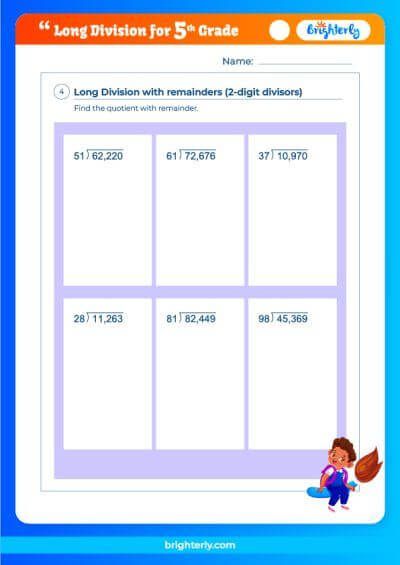How to Teach Long Division: Tips and Techniques
reviewed by Jo-ann Caballes
Updated on June 6, 2025
Long division, or the standard algorithm for division, deals with dividing multi-digit numbers — and that may be easier said than done.
If kids haven’t gained confidence in using multiplication and subtraction, they can struggle even more with learning long division. At the same time, knowing how to multiply and subtract doesn’t help with remembering how to divide step by step, understanding its logic, and being comfortable using it.
If you’ve tried everything and still haven’t found a working long division method, follow this how-to guide. We’ll share some insights and strategies that help kids overcome the most common long division problems.
How to teach kids long division for the first time
You can use different ways to teach kids long division, but the main idea is to clarify its logic so they understand how and why they need it. At a glance, the long division algorithm seems too hard, so the initial task is to make this method look less scary and connect it with already gained knowledge to explain its logic.
How to explain long division and its value? Try using some realistic examples, ideally linked to problems children may encounter. You can describe some real-life dilemmas, like making a cupcake with a big cake recipe or distributing tickets to the same music concert between cities on tour to show when people typically engage in a long division process — and when a calculator doesn’t work alone.
Once you and your audience have reached an understanding of why you need it, you can proceed to teaching long division.
Teaching how to divide: step by step
In this section, we show how to do long division step by step so you can teach it as a systematic, logical, and easy-going process.
Here is the step-by-step long division guide:
- Detect the need to use long division methods
- Make your first division steps
- Get your first results
- Continue dividing until you get a final result
Step 1. Detect the need to use long division methods
Make it clear that the division requires (1) a divisor, (2) a dividend, and (3) a separation between them that comes as a right parenthesis [ ) ] or a vertical bar [ | ].
What to do if there is a problem here? “Divisor” and “dividend” may cause confusion because these words start with the same four letters. In this case, be creative! For example, you can use mnemonic devices to help kids learn these terms. Ideally, they should end with “-sor” and “-dend” and have active/passive analogies.
Example: You can refer to words like “professor” and “student” or “sponsor” and “respondent” to show the difference.
Step 2. Make your first division steps
Find the first digit of a divisor. Then, look at your dividend. Try to divide these two digits and write down the result you get separately.
What to do if there is a problem here? It may happen that the first digit of a divisor is smaller than a dividend. In this case, just use the first two digits of a divisor and write down your result.
Example: You have to divide 146 by 2. In this example, 1 is less than 2, so you should use 14 as a divisor, divide it by 2, and get 7 as the result.
Note: If you have to divide 147 by 21, you should use not 14 and 2 but 14 and 21.
In this scenario, you can use 14 and 2 for division and still get 7. But you should check if this answer works for 21. For this, multiply 7 by 1 (the last digit of your dividend) and see if it matches the last digit of your divisor. Then, multiply 7 by 2 (the first digit of your dividend) and see if it matches the first two digits of your divisor. If all is good, then this answer works.
In the example of dividing 147 by 21, the answer 7 works perfectly.

But it may happen that the first digit of a divisor is not divisible by the first digit of a dividend. To see how to divide, long division recommends to find the closest number less than your digit(s) to divide (you may need to refer to a multiplication table for reference), and write down the result.
Example: If you have to divide 143 by 21, the answer of 7 doesn’t work because it yields 147, not 143. In this case, you should use 6 as the closest answer to your task, multiply 21 by 6, and subtract 21 multiplied by 6 (21 * 6 = 126) from 143.
Step 3. Get your first results
Congratulations! Now it’s time to know that your result is the first digit in your answer and the result you’re looking for is titled “quotient.” Time to get to the next digit in your divisor, divide it by a dividend and get the second digit of your quotient as a result! Basically, repeating this operation helps practice division long method.
What to do if there is a problem here? If your digit was not divisible in the previous step, you will need to subtract the difference between the real digit(s) of a divisor and the number you’ve used to divide. Just add the next digit of your divisor to the subtraction result you’ve got.
Example: You had to divide 356 by 20. In step 2, you divided 35 by 20 and got 1 as the first digit in a quotient. In step 3, you’ve got 15 as a subtraction result of 35-20. In this scenario, your next steps in long division are to write the last digit of your divisor next to your subtraction result and divide it by your dividend. In this example, you get 156 and divide it by 20.
Step 4. Continue dividing until you get a final result
You can repeat steps 2 and 3 until you get your final result. If things go smoothly, you’ll unlock the answer pretty fast!
What to do if there is a problem here? It may happen that when you’ve run out of digits in a divisor, you still have some number left as a subtraction result. Worry not! Leave this number and memorize that it’s called “remainder.”
Example: In our example of dividing 356 by 20, you get the task to divide 156 by 20 as your last step. Since the closest number for the second digit in a quotient is 7, you get 17 as your quotient answer and 156-140=16 as your remainder.
|
13 → quotient 20 ) 356 ____ 156 |
Long division strategies
There are several strategies to master long division, including the standard algorithm, partial quotients method, box method, and mnemonic devices. Let’s see them all so you can choose which one applies to your situation the best.
1. Standard algorithm
In the long division standard algorithm, you use the traditional procedure of dividing, multiplying, and subtracting described in our step-by-step guide above. In this strategy, your task is to get a quotient and a remainder and stop there.
2. Partial quotients
Frequently referred to as the most intuitive for students, the long division strategy of partial quotients lets them break the division problem into smaller, manageable parts and estimate how many dividends fit into a divisor. This method works especially well if kids have learned how to multiply pretty well.
Example: If you need to divide 268 by 2, you start by estimating the quotient that can fit as an answer. If it’s clear that at least 100 groups of 2 will work, you write down 100 in the answer field and subtract 100 multiplied by 2 (100 * 2 = 200) from 268 to get 68.
You repeat the same operation with 68 and get 30 as your next partial quotient and 8 as a subtraction result (68 – 60 = 8). Finally, you get 4 as a final partial quotient (8 / 2 = 4), and calculate the final result as a sum of all quotient parts (100 + 30 + 4 = 134).
| 2 ) 268 – 200 ← 2 x 100 __ 68 – 60 ← 2 x 30 __ 8 – 8 ← 2 x 4 __ 0 |
3. Box method
The box method is a new long division method that introduces an easy-to-follow box structure for all the mathematical operations done. Basically, the procedure is similar to the partial quotients method but the graphic presentation is linear.
| 100 + 30 + 4 = 134 _____________ 2 | 268 | 68 | 8 | | – 200 | – 60 | – 8 | | 68| 8 | 0 | |
4. Mnemonic devices
If kids struggle with remembering the sequence of long division actions, you can introduce some helpful words, sentences or poems to help them remember—just like we’ve offered with the “professor”/”student” example.
In this case, you need to invent words that will start with “d” (for “divide”) and then go to “m” (for ”multiply”), “s” (for “subtract”) and “b” (for “bring down”). The easiest mnemonic device to remember “divide, multiply, subtract, bring down” is “dad, mother, sister, brother.” Another great phrase is, “Does McDonald’s Sell Cheeseburgers?”.
How to teach long division to struggling students
If our step-by-step long division method algorithm is still hard for your students, there is a need to combine several strategies and adjust them to their individual needs. We’ll discover some of your options below.

Nevertheless, you’ll likely need to apply one of these methods during a 1:1 tutoring session with each struggling student, considering that their situations may differ. If that’s your case, we at Brighterly offer professional tutoring sessions for kids who struggle with their math homework. Apply for a free demo lesson to see the details!
How to explain long division to struggling students: 5 tips
Here are some useful tips for explaining long division to struggling students:
- Normalize mistakes
- Visualize the long division process
- Turn learning into a game
- Find helpful tools
- Practice, repeat, and track progress
1. Normalize mistakes
It’s hard to be patient seeing a student make the same mistake over and over. But that’s critical to let them learn as long as they need, even if it means finding different ways to explain the same thing until they get it. With struggling students, it’s better to concentrate on progress, not perfection.
2. Visualize the long division process
Math is an abstract science, but a hands-on approach makes it more understandable for kids. Use the box method or real objects like apples and flowers to illustrate the logic and relationships between multiplication, division, and subtraction.
3. Turn learning into a game
You can make your math class more entertaining by introducing challenges into the long division studying process. It can be dividing as many digits as possible or solving a complicated long division task as a team.
4. Find helpful tools
Introduce work mats, organizers, visual aids, and technology whenever you see kids struggling with a specific step in a long division process. The more angles they see and tools they have, the higher the chances your students get your long division explanation.
5. Practice, repeat, and track progress
The best way to teach long division is to turn it into an ongoing process. Like any other skill, long division needs constant practice, even when learned. Thus, keep your students practicing and encourage their progress with rewards.
How to teach kids to estimate long division problems
Long division problem estimation is an angle used to explain long division. It means that you use any method mentioned above but explain it as a problem-solving technique.
In other words, you start with a solution and explain both how to learn long division and how to apply the right method to get the expected solution. It brings kids more confidence and autonomy as a result.
Here are some ways to help kids estimate long division problems, or apply the long division methods to the solution they want to get.
1. Partial quotients
In this method, you start by determining the final result as a solution in Step 1. For this, you find partial quotients or break down the problem into smaller steps that eventually bring you to the desired outcome.
2. Box method
While referring to the box method, kids determine their long division problem as a lack of visualization for an abstract math operation. In this case, boxes help them track the relationship between multiplication and division and get the quotient.
3. Hands-on approach
Going for a hands-on approach is the next step in visualizing long division operations and getting a better understanding of its logic. By using blocks in class, you provide kids with a model to solve long division problems that explains what happens with a divisor and a dividend on the way.
4. Real-world examples
Whenever facing frustration, search for real-world examples to introduce familiar concepts that can explain long division logic. You can refer to sharing snacks, dividing pages in a book or estimating the cost of groceries for this. The closer your object is to the class, the better.
5. Long division worksheets
Long division problems may appear long after its logic is learned, and practice and repetition are a solution to them. In this regard, long division worksheets are the best tool to refresh the long division skills, regain confidence, and make progress.

How to teach long division to grade 3
To teach long division to grade 3 kids, use all the possible means for visualization, don’t require speed and accuracy, and use one-digit dividends only. These students need more attention and a more thoughtful explanation of long division.
Main long division problems for grade 3 students:
- Remember the steps
- Remember multiplication facts
- Dealing with the remainder
The key task: To help kids remember the steps and gain fluency with multiplication facts.
Step-by-step guide to teaching long division to grade 3
1. Explain the concept
Use real-world facts and take enough time to explain the logic behind long division
2. Practice division and multiplication facts
Apply flashcards, tests, and games to remind multiplication and division facts.
3. Show the box method
The box method is the best approach to use for grade 3 students because it helps to visualize the process of multiplication and division and track the long division more easily.
4. Use mnemonic devices
Mnemonic devices are another useful long division method that helps with remembering the steps.
5. Provide practice and feedback
Let grade 3 students practice long division at home and track their progress in class, increasing the difficulty of the tasks given gradually.
How to teach long division to grade 4
Regarding long division steps, 4th grade students are already expected to deal with multiplication facts faster and have no problems with remembering the sequence “divide, multiply, subtract, bring down.” Thus, you can proceed to master the long division standard algorithm to improve efficiency and speed.
Main long division problems for grade 4 students:
- Master the long division algorithm
- Improve speed and efficiency
- Deal with 4-digit divisors
The key task: Bring confidence in dealing with long division with 4-digit divisors
How to teach to grade 4: Long division steps
1. Review the long division skills
Warm up by determining the concept of long division, division and multiplication facts, and the steps in the process.
2. Show different long division strategies
Resolve the same tasks with different strategies to detect the one that works best for the students.
3. Steadily increase the difficulty of long division tasks
Aim at increasing the complexity yet encourage peer-to-peer learning and introduce helpful tools whenever needed.
4. Repeat and practice
Use long division worksheets for grade 4 to practice working with 4-digit divisors and ensure constant learning and practicing the skill.

How to teach long division to grade 5
Long division grade 5 step-by-step guide depends on the progress of the class in grade 3 and grade 4.
Ideally, it’s time to proceed to deal with 5-digit divisors and 2-digit dividends, but the exact teaching method will depend on the learning capabilities of the students. In any case, it’s worth concentrating on teaching kids to estimate long division problems and increase their autonomy to find the right tool to deal with them.
Main long division problems for grade 5 students:
- Master solving long division problems
- Increase complexity yet maintain speed and efficiency
- Deal with 5-digit divisors and 2-digit dividends
The key task: Make long division logic clear and deal with it fast, efficiently, and independently.
5th grade long division steps for teaching
1. Review long division skills
Check the progress and complexity of the class, refresh the knowledge and skills if needed.
2. Let students choose their long division strategy
Focus on long division problem estimation in determining the best long division strategy.
3. Steadily increase the difficulty of long division tasks
Steadily increase the number of digits in divisors and dividends and check if speed and efficiency issues appear.
4. Repeat and practice
If possible, design an individual plan for each student, considering their long division problems and areas for improvement. Using long division worksheets is useful at this stage.

If you need more diverse materials to practice, check out these long division worksheets with numerous examples relevant to 5th grade students.
Conclusion
Teaching long division is not easy, but manageable with the right approach and by applying different long division strategies.
Our key recommendation is to use our step-by-step long division guide as the basic explanation. Then, you can determine the most typical problems and the most difficult steps in the process. After this, you can apply a more specific long division strategy and use one of the personalized ways to explain long division to struggling students.
We believe that long division is a skill that requires constant practice and special attention. That’s why we recommend applying different long division worksheets, visualization means, strategies, and individual sessions with a math tutor whenever needed. Brighterly can help with this – and many other math problems your kids may encounter.
By following our guidelines and adjusting different methods to different grade students, you can learn how to teach long division effectively. Don’t lose patience when they make mistakes and keep searching for more tools to explain long division logic, and you’ll get the desired progress in the class.















